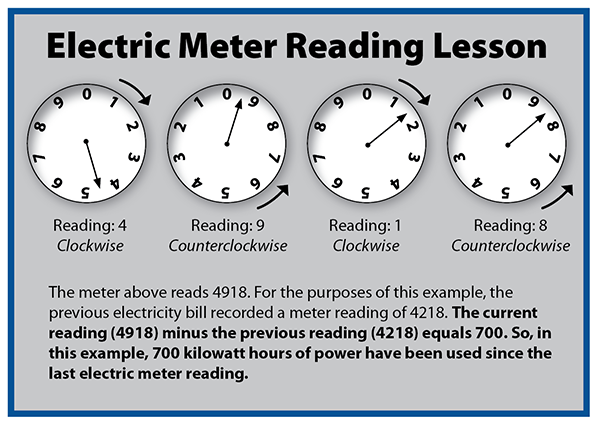Electric Bill Made Easy
 Understanding how to read your electric bill is important. The bill is required to include several pieces of information to help consumers know how much electricity they have used and how much it will cost them. The Office of the Ohio Consumers’ Counsel (OCC) developed this fact sheet to help consumers better understand their electric bills.
Understanding how to read your electric bill is important. The bill is required to include several pieces of information to help consumers know how much electricity they have used and how much it will cost them. The Office of the Ohio Consumers’ Counsel (OCC) developed this fact sheet to help consumers better understand their electric bills.
Read your bill monthly
It is important that you read your bill each month, look for any unusual charges, and keep track of your normal electricity usage. Your bill may also contain important updates. If you have an alternative supplier, you may see additional charges on the same or separate bill.
Establishing Service
To set up the utility service, contact your local electric utility, and give them your service address, personal information, and start date. Your landlord, realtor, or seller should know who provides electric service at your new address. If a meter is present, the utility company must start the service within three business days of your request. Ask when you can expect your first bill. The utility has more time to start service if a new meter needs to be installed. Check with the utility company.
Creditworthiness
Before you can establish service in your name, the utility may require you to make sure you can pay for service by checking your credit. To establish credit with the utility, you must meet one of the following criteria:
- Be a creditworthy property owner; or
- Have a prior account with a similar type of utility within the past two years, and not had more than two late payments, or had service disconnected in the past year; or
- Secure a guarantor, who is a customer of the utility, to pay for up to 60 days of service if you fail to pay your bill.
If you do not meet the criteria, you may be required to pay a deposit to establish credit with the utility. The deposit may not exceed an average 30-day bill plus 30 percent. If the utility keeps your deposit for more than six months, it must pay interest on the deposit. After 12 months, the utility will review your account and determine if the deposit should be refunded or credited to the account.
When paying a deposit, the utility should send you a receipt with the following information: name, address, deposit amount, length of time the deposit must be held by the utility to qualify for interest, the interest rate to be paid, and conditions for refunding your deposit.
Usage and meter reading
The amount of electricity consumers use each month is measured in kilowatt hours (kWh).
Electric utility companies are increasingly using advanced meters (i.e. smart meters) equipped with two-way communication technology to provide real-time meter readings.
Automated meters allow utilities to regularly obtain actual meter readings. If you don’t have one, the company may not always be able to read your meter and can use estimated readings to calculate your usage. Consumers can request two actual meter readings per calendar year if their bill has been estimated for more than two consecutive months. Consumers also may be able to provide their own meter readings to the electric company. Contact your utility first to verify.
The OCC recommends that you learn how to read an electric meter to make sure you are being charged the right amount. See below to learn more.
Fees and charges
Electric bills have four charges that when added up determine how much you owe:
- Customer Charge – A fixed fee established to pay for the costs associated with electric equipment and maintenance;
- Generation Service Charge – A kilowatt-hour based volumetric charge to produce electricity;
- Transmission Service Charge – A kilowatt-hour-based volumetric charge moves high-voltage electricity from power plants to the electric company; and
- Distribution Service Charge – A kilowatt-hour-based volumetric charge for delivering electricity to your home, including the use of local wires and other equipment to move electricity.
Some electric utilities could list other company-specific charges or credits. Bills have an area for an explanation of terms or definitions for charges you may not understand.
Required items on bills
Your electric bill must include your name, address, account number, payments/credits on your account, and the Price to Compare. It also shows billing information, contact details, usage history, and late payment fees.
The Price to Compare is the electric utility’s price for generation and some related transmission charges. You may be able to save money by choosing a supplier with a lower rate. Learn more with OCC’s How to Make Wise Energy Choices fact sheet at: www.occ.ohio.gov/factsheet/wise-energy-choices.
Budget Billing
Ohio’s regulated electric utilities offer budget billing plans that allow customers to pay a fixed monthly amount to avoid high bills during heating and cooling seasons.
Each utility has its own unique budget billing plan that lasts for up to 12 months. The utility may review the account periodically and adjust the budget amount accordingly. Customers are responsible for any remaining balance at the end of the budget period or they may receive a credit for any overpayment.
To cancel or enroll, contact your utility directly and review the terms and conditions before signing up.
PIPP Plus customers
The Percentage of Income Payment Plan (PIPP Plus) is a payment arrangement to help eligible electric (and natural gas customers) pay their utility bills. Consumers enrolled in PIPP Plus cannot be charged a security deposit to establish service. For more information about PIPP Plus see OCC’s Know the Facts: PIPP Plus fact sheet.
Paying the bill
There are different ways to pay your electric bill. Some are free, like automatic direct payments and online bill payments. Others cost extra, like using a credit card or electronic check, or paying at agent locations.
It is important to allow for processing time when paying your bill. OCC encourages consumers to pay well before the due date to avoid disconnection. In addition, the Federal Trade Commission encourages consumers to use a secure browser, read the privacy policy, keep records of their payments, and review their credit card statements if they are paying online.
Electric Utility Sample Bill and Contact Information
How to Read Your Analog Meter
Knowing how to read an electric meter is easy to learn and a valuable skill to have as an educated utility consumer. Consumers who can read their meter can effectively monitor their usage, and avoid being overcharged or undercharged for their electric usage.
The glass-enclosed electric meter is almost always round in shape and found outside the home. The electric meter has four round clock-like dials with digits 0-9 displayed on each one and a spinning disk beneath them, which speeds up and slows down as usage increases and decreases. Newer digital meters also are becoming increasingly used by electric utilities to track electricity usage and are easier for consumers to read, because they display the numbers for you.
Consumers can figure out how to read an electric meter by using the following steps:
- Locate the four dials and always remember to read them from left to right. The pointer on the first dial of an electric meter circles clockwise, the second dial turns counterclockwise, the third moves clockwise and the fourth travels counterclockwise.
- Notice the pointer in each dial and write down the number indicated by its position. When the pointer is between two numbers, the reading for the dial is the smaller of the two numbers.
- If the pointer is directly on a number, that number is the reading. When it is difficult to tell if a pointer is directly on a number, look at the dial directly to the right. If the pointer on that dial has not passed zero, record the smaller number of the two.
- To discover how much electricity has been used since the last meter reading, subtract the actual reading indicated from the last utility bill from the consumer’s manual reading. After this first reading, consumers can track their own electricity usage and compare them against the monthly bill sent by the utility. Electricity is measured in kilowatt hours (kWh).
- To monitor electricity usage on a daily or weekly basis, schedule a time to do a reading. Return at the same time the next day or next week to read the meter again. Determine the usage by subtracting the previous reading from the latest reading.
Remember, utilities are required by law to provide one electric meter reading per year, but usually provide actual reading more frequently. Consumers also should be aware that an actual meter reading is required to begin or end electric service if the meter was not read in the previous 60 days prior to the initiation or termination of service.
If consumers know their meter has not been read in the last 12 months, contact the company to schedule a reading date and remember to take an independent reading on that day as well. While you may be required to pay for usage that was not previously billed, consumers have rights to special payment plans.
If there is a sizable difference when comparing the readings, this could result in an overcharge or undercharge on the next billing statement. In either case, report the discrepancy to the utility. You might inquire about having the meter tested.
NOTE: Learning how to read your utility meters gives you a good indication of what your bill will be, rather than the precise amount you will pay. Remember that there are other components of a utility bill in addition to the basic rate which might affect the amount you are required to pay.
To download: Click the folder with a down arrow icon. To print: Click the printer icon in the top right of the display.
If you need multiple copies for an organization or group, please contact a member of our outreach team.
